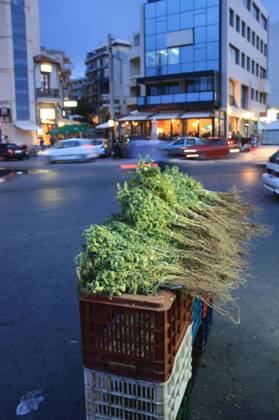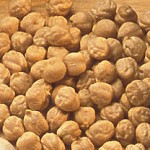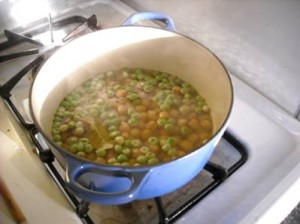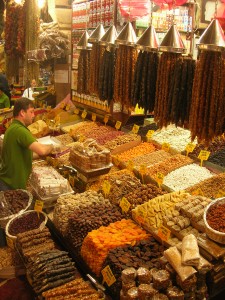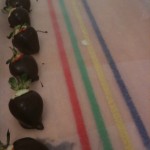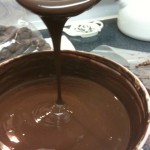Hey, Chickpea
Another dive into my pantry this winter has uncovered my favorite bean: the garbanzo, otherwise known as the chickpea. In Italian, the word for this little member of the pea family is ceci pronounced “che-chi”. “Garbanzo” comes from the Spanish calavance or garvance. Why a simple pea has so many different names is beyond me, but needless to say it’s delicious.
Traveling to Crete this past spring on a high-speed ferry, I sat in a stiff chair with a blazing three-aspirin headache, wondering if I was going to make it to the island before I started feeling like the Cyclops from the Odyssey. Fortunately the ferry arrived to the island in the same time it took the aspirin to do its job. Getting off the boat, I stumbled onto solid land at the Irakclio dock in woozy post-headache relief, just as the sun melted behind a line of dark blue Cretan mountains into a pool of neon pink.
 Walking onto the street with my giant pack, I was greeted by a street vendor who’d stacked bunches of brilliant green stalks atop milk cartons beside his cart. Walking closer, I discovered that the stalks were in fact in the pea family, and that this vendor was selling fresh chick peas on the stem.
Walking onto the street with my giant pack, I was greeted by a street vendor who’d stacked bunches of brilliant green stalks atop milk cartons beside his cart. Walking closer, I discovered that the stalks were in fact in the pea family, and that this vendor was selling fresh chick peas on the stem.
I suppose there should be a unique category of euphoria for discovering the tastiness of something fresh and raw that previously you’ve only known as cooked or dried. Imagine only knowing a raisin and then discovering a grape. Or only eating prunes until someone presents you with a plump, ripe plum.
Upon discovering the fresh chickpea, whose flavor has even more depth and richness than an ordinary fresh garden pea, I thought to myself: “why aren’t we eating these all the time?” The answer being that it’s a lot of work to shell these little guys. After buying a bunch of stalks from the vendor for 1 Euro, I headed to a youth hostel with my friend and traveling companion, Tamara, and the two of us sat on our beds and shelled and ate chick peas for close to an hour. It was like eating candy. The fuzzy pods contained generally one or two chickpeas, and sometimes squeezing them to extract the peas would make them fly out of their pod across the room. The peas were bright green and firm and would’ve been delicious in a rice salad with sun-dried tomatoes and olives. But alas, we were at the mercy of traveling and when we’d found all the peas we could, we looked around at the mess of empty pods and leaves on the beds and realized we were still hungry. Despite their divine sweetness and crunchy texture, a bunch of raw chickpeas doesn’t make a dinner.
But a bunch of dried chickpea does. When you’re not on the island of Crete but rather navigating your way through a cold, snowy winter, chickpeas can either be bought dry by the bag like other beans, or pre-soaked by the can. Buying them by the bag is certainly more economical, but it takes the foresight to soak them overnight. Still, some things are worth the foresight, and it’s a lot easier than shelling them from the pod.
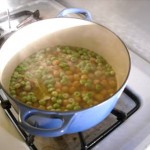 The versatility of this pea is astounding. Chickpeas can be added to stews or baked on a cookie sheet as a snack or pureed into a spicy soup or combined with tahini to make hummus. Its richness and cooling character make it a wonderful base for herbs and spices, which is why it can be found as an ingredient in a variety of cultural dishes from Italy to India.
The versatility of this pea is astounding. Chickpeas can be added to stews or baked on a cookie sheet as a snack or pureed into a spicy soup or combined with tahini to make hummus. Its richness and cooling character make it a wonderful base for herbs and spices, which is why it can be found as an ingredient in a variety of cultural dishes from Italy to India.
 One of the most delicious recipes I’ve found for chickpeas is an Italian style salad that makes a great dish to bring to a dinner party or alternatively, makes an easy lunch to bring to work. This recipe is very flexible, so if you want to add other veggies or olives or spices, go for it. The dressing is carefully crafted though, and worth the measurements. If you have fresh herbs, all the better, but I’ve listed amounts for dried ones since it’s wintertime.
One of the most delicious recipes I’ve found for chickpeas is an Italian style salad that makes a great dish to bring to a dinner party or alternatively, makes an easy lunch to bring to work. This recipe is very flexible, so if you want to add other veggies or olives or spices, go for it. The dressing is carefully crafted though, and worth the measurements. If you have fresh herbs, all the better, but I’ve listed amounts for dried ones since it’s wintertime.
 Don’t use dried parsley though if you can help it. Fresh parsley is readily available and makes all the difference. Store it like fresh flowers in a vase and it will stay fresh for two weeks. Annie suggests serving this with grilled eggplant and big, flat croutons. Yum!
Don’t use dried parsley though if you can help it. Fresh parsley is readily available and makes all the difference. Store it like fresh flowers in a vase and it will stay fresh for two weeks. Annie suggests serving this with grilled eggplant and big, flat croutons. Yum!
-Claire-
***********************************************************************************
Chick-pea and Sun-dried Tomato Salad
Adapted from Annie Somerville’s Fields of Greens
Bantam, 2003
Serves 4-6
1 1/2 cups dried chickpeas, about 9 oz soaked overnight
1 bay leaf
1/2 tsp dried oregano
1/2 tsp dried red pepper flakes
1/2 cup frozen or freeze-dried green peas
1/2 small red onion, diced about 1/2 cup
Champagne vinegar
1/4 cup red wine vinegar
1 garlic clove, finely chopped
Salt and pepper
2 tablespoons extra virgin olive oil
2 sundried tomatoes packed in oil, drained and diced about 1/4 cup
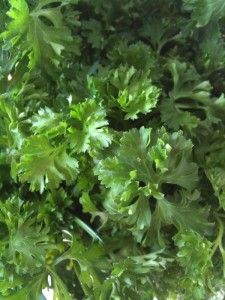 2 tablespoons chopped fresh flat-leaf parsley
2 tablespoons chopped fresh flat-leaf parsley
Drain and rinse the chickpeas, place in a large saucepan and cover generously with water. Add herbs and bring to a simmer. Cook for 50-60 minutes.
Meanwhile bring a small pot of water to a boil, add the onion, and cook for 15 seconds. Drain and toss with a splash of Champagne or white balsamic vinegar. Combine the red wine vinegar, garlic, 3/4 tsp salt and few pinches of pepper in a bowl. Gradually whisk in the oil.
When the chickpeas are tender, add the green peas and cook for 1-2 minutes more. Drain, then toss immediately with the vinaigrette, onion, and sun-dried tomatoes. Marinate for an hour, toss in the parsley, and serve.

